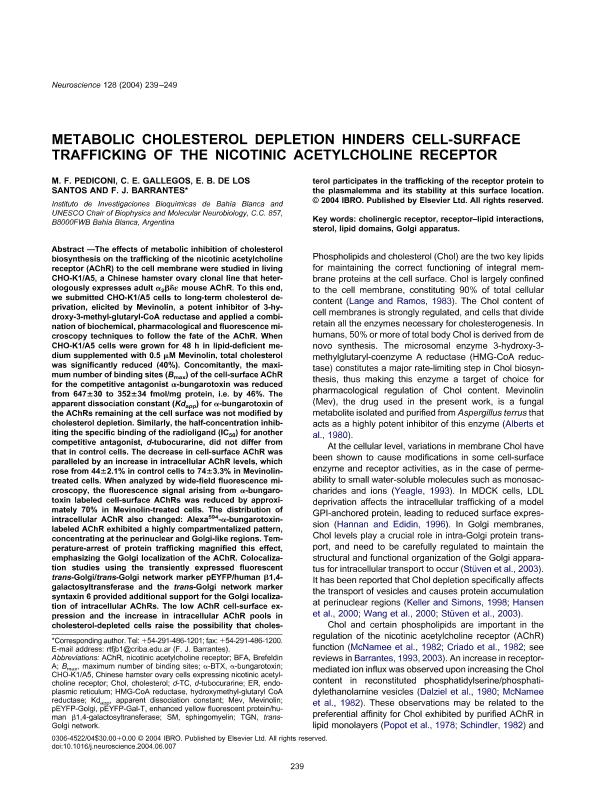Artículo
Metabolic cholesterol depletion hinders cell-surface trafficking of the nicotinic acetylcholine receptor
Pediconi, Maria Filomena ; Gallegos, Cristina Eugenia
; Gallegos, Cristina Eugenia ; de Los Santos, Elisa Beatriz
; de Los Santos, Elisa Beatriz ; Barrantes, Francisco Jose
; Barrantes, Francisco Jose
 ; Gallegos, Cristina Eugenia
; Gallegos, Cristina Eugenia ; de Los Santos, Elisa Beatriz
; de Los Santos, Elisa Beatriz ; Barrantes, Francisco Jose
; Barrantes, Francisco Jose
Fecha de publicación:
12/2004
Editorial:
Pergamon-Elsevier Science Ltd
Revista:
Neuroscience
ISSN:
0306-4522
Idioma:
Inglés
Tipo de recurso:
Artículo publicado
Clasificación temática:
Resumen
The effects of metabolic inhibition of cholesterol biosynthesis on the trafficking of the nicotinic acetylcholine receptor (AChR) to the cell membrane were studied in living CHO-K1/A5, a Chinese hamster ovary clonal line that heterologously expresses adult α 2βδε mouse AChR. To this end, we submitted CHO-K1/A5 cells to long-term cholesterol deprivation, elicited by Mevinolin, a potent inhibitor of 3-hydroxy-3-methyl- glutaryl-CoA reductase and applied a combination of biochemical, pharmacological and fluorescence microscopy techniques to follow the fate of the AChR. When CHO-K1/A5 cells were grown for 48 h in lipid-deficient medium supplemented with 0.5 μM Mevinolin, total cholesterol was significantly reduced (40%). Concomitantly, the maximum number of binding sites (B max) of the cell-surface AChR for the competitive antagonist α-bungarotoxin was reduced from 647±30 to 352±34 fmol/mg protein, i.e. by 46%. The apparent dissociation constant (Kd app) for α-bungarotoxin of the AChRs remaining at the cell surface was not modified by cholesterol depletion. Similarly, the half-concentration inhibiting the specific binding of the radioligand (IC 50) for another competitive antagonist, d-tubocurarine, did not differ from that in control cells. The decrease in cell-surface AChR was paralleled by an increase in intracellular AChR levels, which rose from 44±2.1% in control cells to 74±3.3% in Mevinolin-treated cells. When analyzed by wide-field fluorescence microscopy, the fluorescence signal arising from α-bungarotoxin labeled cell-surface AChRs was reduced by approximately 70% in Mevinolin-treated cells. The distribution of intracellular AChR also changed: Alexa 594-α- bungarotoxin-labeled AChR exhibited a highly compartmentalized pattern, concentrating at the perinuclear and Golgi-like regions. Temperature-arrest of protein trafficking magnified this effect, emphasizing the Golgi localization of the AChR. Colocalization studies using the transiently expressed fluorescent trans-Golgi/trans-Golgi network marker pEYFP/human β1,4- galactosyltransferase and the trans-Golgi network marker syntaxin 6 provided additional support for the Golgi localization of intracellular AChRs. The low AChR cell-surface expression and the increase in intracellular AChR pools in cholesterol-depleted cells raise the possibility that cholesterol participates in the trafficking of the receptor protein to the plasmalemma and its stability at this surface location.
Archivos asociados
Licencia
Identificadores
Colecciones
Articulos(CCT - BAHIA BLANCA)
Articulos de CTRO.CIENTIFICO TECNOL.CONICET - BAHIA BLANCA
Articulos de CTRO.CIENTIFICO TECNOL.CONICET - BAHIA BLANCA
Articulos(INIBIBB)
Articulos de INST.DE INVEST.BIOQUIMICAS BAHIA BLANCA (I)
Articulos de INST.DE INVEST.BIOQUIMICAS BAHIA BLANCA (I)
Articulos(SEDE CENTRAL)
Articulos de SEDE CENTRAL
Articulos de SEDE CENTRAL
Citación
Pediconi, Maria Filomena; Gallegos, Cristina Eugenia; de Los Santos, Elisa Beatriz; Barrantes, Francisco Jose; Metabolic cholesterol depletion hinders cell-surface trafficking of the nicotinic acetylcholine receptor; Pergamon-Elsevier Science Ltd; Neuroscience; 128; 2; 12-2004; 239-249
Compartir
Altmétricas



